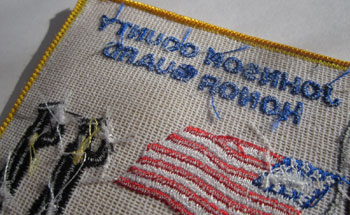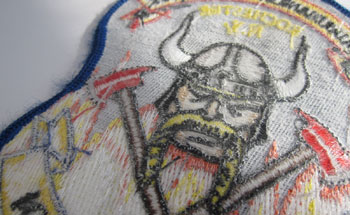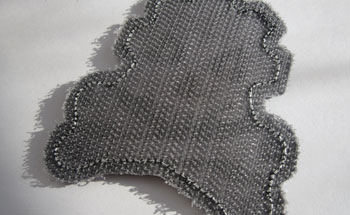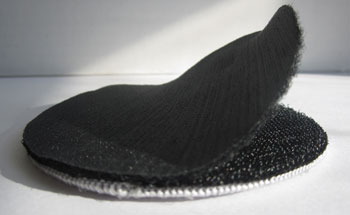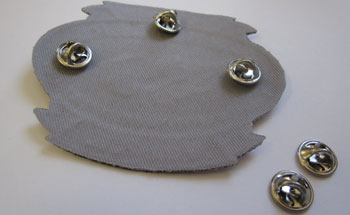Custom Patches Backing
|
No Backing
Embroidered patches can be made without a backing. If fact, they start out that way. These patches will show the twill or threads on the backside of the patch, and are generally more flexible. Patches without backings do not have the same thickness or stiffness as patches with backings; therefore, the best occasion to order patches without backings is when they will be sewn onto garments or other types of fabrics. Click on the image for a close-up, detailed view of the back of this non-backing patch. |
Plastic Backing (Add $0.1 each)
Plastic backing adds stiffness and support to the patch allowing it to stay flat over time while still leaving the patch thin enough to be sewn onto a garment.we includes plastic backing at no extra charge. Plastic can be used with any patch, regardless of size, shape, or border type. Plastic on the back of a custom patch will appear thin and matte. If you click the image above for a close-up, you will be able to subtly see the difference in texture in comparison to the non-backing patch shown in the ‘no backing’ example. |
|
|
Heatseal Backing (Add $0.1 each)
Also known as iron-on, heatseal allows patch application to your garment via home iron. Heat seal backings add some stiffness to patches, allowing them to lay flat. Some patch companies rate their iron-on backing for 20-30 washes, while others, including CustomPatchesMade, use more robust adhesives to achieve 50-80 washing cycles. When using heatseal, it is advisable to sew a few stitches to hold the patch in place. Heat seal doesn’t work with nylon, and other synthetic fabrics. Capturing the look of heatseal with a photograph is difficult;The heatseal gives the patch a shiny coating that will melt and adhere to the fabric when heated. |
Adhesive Backing (Add 13%)
Also known as peel and stick, adhesive, in a sense, turns your patch into an embroidered sticker. A glue is pressed onto the back of the patch, then is overlaid with paper to be peeled off at the time of use. An adhesive backing is a non-permanent option when applied to fabric or clothing; therefore, it is best for a single event. Although the glue is much stronger than what you will find on an average paper sticker, it will not withstand a cycle in the washing machine, and will also weaken over time. For permanent application, order your custom patches with plastic or no backing and sew them to your garments. The paper backing for adhesive patches can fit the shape of the patch, as shown above, or it can be oversized, for quick and easy peeling and application. Click the image above for to view an example of adhesive patches with oversized paper backing. |
|
|
Hook-Sided Velcro Backing(Add 20%)
Velcro backings tend to be used in Military applications such as morale patches, where removing and reapplying patches happen frequently. Hook and loop fasteners are available in one side or two sides. If your uniform or garment already has a loop fastener area, one-sided Velcro is the best choice. One-sided Velcro is our most popular Velcro option, comprising upward of 95% of Velcro orders. As you can see, we offer Velcro backing in other colors besides black, including,but not limited to green, brown, and shades of gray. |
Two-Sided Velcro Backing (Add 35%)
If your uniform or garment does not already have a loop fastener area, two-sided Velcro is the best choice. This backing comes with both the hook and loop side. All you have to do is sew the loop fastener to your uniform. CustomPatchesMade Difference: Many patch companies glue the Velcro backing to the patch creating weak points that eventually cause the Velcro to un-attach itself from the back of the patch. Stadri chooses to sew the backing and patch together for a stronger bond and longer life. |
|
|
Magnetic Backing(Add 25%)
Half-inch magnetic discs are attached to the patch turning the patch into an embroidered (or woven) magnet. The amount of magnets attached to the patch depends on the patch’s size; however, they are super-stong-one magnet is usually sufficient for a standard three inch patch. Even so, a three inch patch comes with two magnets, so you never have to worry about their performance. |
Pin Backing(Add 13%)
When the patch is being created, a pin is placed inside the layers of backing, twill, and thread, allowing the patch to be used as a pin or brooch. Once pinned through the garment, butterfly clutches (included) are used to secure the patch. This is ideal for frequent location changes, such as hand bags or different jackets for different times of the year. |
|
|
Security Backing(10%)
Security backing is a layer of thin plastic with your company name or any other information you desire printed onto the plastic. If you are a reseller of patches this backing is ideal-if your customer ever forgets where his or her patches came from, the backing will be there as a reminder. Security backing also prevents theft and plagiarism of patches. Of course, it is only effective if the patch is not being affixed to a fabric. |
Button Loop Backing(Add 9%)
A loop of thread is attached to the back of the patch, creating a loop for a button to pass though. Although glued, they hold up extremely well-the only weight they are supporting is the weight of the patch. More often than not, the Boy Scouts of America and other Scouting organizations order their patches with button loops, allowing the patches to hang on a button of their uniforms. |

